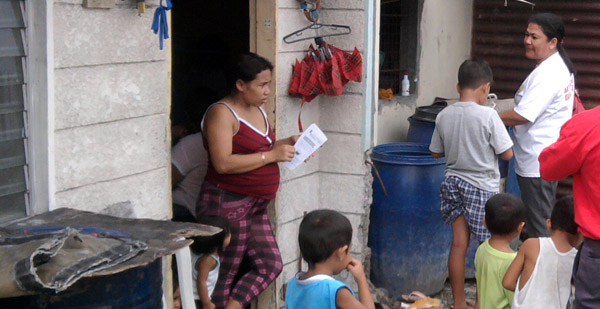
|
IN THIS PHOTO:
|
|
LISTEN, FOLLOW
City health personnel in a huddle with community members while discussing dengue and ways to prevent it from spreading in this March 2013 file photo. |
| View Gallery |
|
IN THIS PHOTO:
|
|
LARVITRAPS
Program Against Dengue action officer Dr. Edgardo Aruelo prepares "larvitraps" in a community forum, in this May 2012 file photo. The larvitraps planted in 15,900 houses all over the city is designed to lure mosquitos and lay their eggs in the isolated water-filled can. |
| View Gallery |
|
IN THIS PHOTO:
|
|
TRAPPED
A barangay health personnel harvests water from a larvitrap in Tugatog where mosquitos were led to lay their eggs. This system makes it easy to control breeding of mosquitos |
| View Gallery |
|
IN THIS PHOTO:
|
|
SEARCH, DESTROY
An MMDA personnel spray anti-mosquito mist and a backhoe clears a section of the Lingunan river in Valenzuela, April 2014 file photo. The city government moreover carry out a menu of anti-dengue initiatives all year long. |
| View Gallery |
|
IN THIS PHOTO:
|
|
BEGINS AT HOME
A housewife listens to a briefing from city and barangay health personnel during an Oplan Sita where inner communities are inspected for possible breeding spots of dengue-carrying mosquitos, in this file Oct. 2010 file photo. |
| View Gallery |


No one died of dengue hemorrhagic fever in Valenzuela City in 2014 – a first in 17 years – the local health bureau reports.
Records of the City Health Office show a total of 397 dengue cases in the same year, a decrease by 43 per cent from the 718 in 2013 and the lowest in 11 years.
The number of dengue cases has been steadily declining for the last four years.
In 2010, cases jumped to 1,693, more than half of the 840 in 2009 and the highest from 1998 to 2014. It would slightly decrease for the next two years, until in 2013, when the 1,397 in 2012 dived to 718.
Meanwhile, 81 cases have been recorded from January 1 to March 7, 2015, 98 percent higher than the 41 recorded in the same period in 2014. No death has been recorded so far.
Dengue fever is caused by the dengue virus carried by the female of the mosquito species Aedes aeqgypti and Aedes albopictus, the World Health Organization (WHO) says.
The illness bears resemblance to flu, with symptoms such as high fever lasting up to seven days, nose bleeding, nausea, and vomiting.
It is common in tropical and subtropical countries where rain is frequent.
‘Isang lata ka lang’
Dr. Edgardo Aruelo, Program Action Officer Against Dengue, said the zero death case last year was brought about by a mix of interventions by the City Health Office aimed at combating the mosquito-borne disease.
The larvitraps planted in 15,900 houses all over the city is a preventive measure against dengue, allowing homeowners to kill mosquito larvae.
Fashioned out of a tin can, the improvised trap is filled with water and placed on an isolated spot in the house where it becomes a breeding site for mosquitoes. After five to seven days, the larvae are harvested.
While in most places it is usually done only during the first quarter of the year in preparation for the rainy season, larvitrapping is done the whole year round in Valenzuela City, said Dr. Aruelo.
The office is promoting the use of larvitraps with the slogan, “Dengue, isang lata ka lang (Dengue, you don’t stand a chance against a single tin can).”
Andrea de Jesus, health education officer, said the amount of larvae collected in the larvitraps also indicates whether the community is running the risk of an outbreak. If at least ten percent of the larvitraps in a community, which usually has around 30 larvitraps, turns out to contain larvae, it is a signal for the office’s Operation Plan (Oplan) Sita (Rebuke) team to descend on the community and do fogging.
Through fogging, mosquitoes are killed by blasting the environment with smoke formed from a mixture of water and insecticide. It is done in the early morning and early evening.
Of the zero-death feat, Dr. Aruelo said, “It is a concerted effort of the City Health Office and barangay and school dengue brigades.”
Unplanned urban development
Dr. Aruelo said controlling dengue has been difficult especially because of two reasons.
One is climate change. “Today, the rainy season is coming earlier than previous years. Frequent rains are an ideal condition for the dengue-carrying mosquito, because the environment becomes more suitable for egg-laying,” Dr. Aruelo said.
Another is what Dr. Aruelo calls “unplanned urban development,” which best example is the growing number of informal settler communities in cities.
Dr. Aruelo pointed out that many informal settler communities lack proper water systems, so people store water in containers instead but leave them uncovered, attracting mosquitoes to lay their eggs on them.
Waste management in these communities is also poorly practiced, Dr. Aruelo said. “People dump their trash where they shouldn’t,” he said.
When the spread of dengue is largely because of human-made reasons, education becomes as necessary as larvitaps and fogging.
That is why the Oplan Sita team includes a health educator who holds lectures on how communities can keep dengue-carrying mosquitoes from breeding in their surroundings.
 Latest News
Latest News Archive
Archive Category
Category

